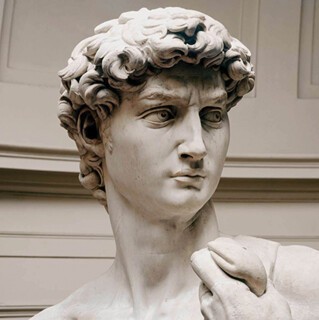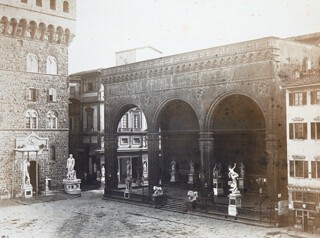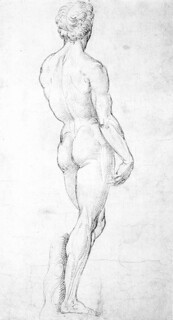In December 1520, the abbot of the Cistercian monastery of Clairvaux paid a visit to Florence on his way to Rome. Approaching the seat of government in the Piazza della Signoria, he stopped in front of Michelangelo’s 15-foot David. He didn’t see in it a symbol of the Florentine nation or even identify the figure. For the abbé, it was ‘a great phantasm of white marble, well worked and all of one piece’ (‘ung grand fantosme de marbre blanc, bien ouvre et tout dune piece’). Fantosme can be translated as ‘ghost’, though the word left it unclear whether the apparition existed in the world or in the viewer’s imagination. (Phantasms were associated with the imaginative faculty, or phantasia. Potentially leading to thought of a higher order, the constructions of the phantasia were also susceptible to demonic influence.) The abbé had no trouble seeing the giant statue as a material work of human art, made of marble and carved out of one piece, a distinction claimed for some famous ancient statues. At the same time, he had trouble keeping Michelangelo’s statue in the realm of bounded and firm things.
He had probably never seen anything like the David, but his imagination would have been full of such figures. Medieval Christian artists depicted the naked statues of pagan antiquity in elaborate temples or great fora, presiding over populations, demanding veneration, vomiting devils or revealing themselves to be devils. They grimace, they bend over, sometimes they break apart under the impact of the triumphant Christian faith, which explained why so many of them were now in fragments. The David has long since lost its original polish – it did after all spend almost four centuries outside before being moved to the Accademia – but newly installed, with its belt of 28 gilt leaves, the gleaming white giant would have had more than a touch of the phantasm about it.
‘Status igitur unde statuae dictae’ (‘because they stand they are called statues’), Pomponius Gauricus wrote in his treatise on sculpture of 1504. Statues are works of art that stand by themselves, in the form of figures that enact the standing. This redundancy is at the heart of the uncanny effects of autonomy and animation regularly invoked in accounts of statues over the centuries. Sculpture in the round was not unknown in medieval art, but an implicit decorum demanded that it be contained by an architectural framework – embedded in portal decoration, for example, or set into niches and tabernacles. In the Christian imagination, the free-standing statue on a column was an emblem of pagan idolatry: a usually naked figure allowing access from all sides, often inciting raucous dancing en ronde – behaviour ungoverned by priestly authority or ceremony. To be able to see the divine figure from behind, violating a prohibition imposed by God on Moses, was a transgression associated with the Devil.
Michelangelo’s statue began dutifully as a work of cathedral sculpture, intended for a position high up on one of the buttresses ringing Brunelleschi’s cupola, at a safe remove from the populace, its back towards the building. It was projected as one in a series of prophets to be installed on the buttresses. Earlier in the 15th century, terracotta figures of Joshua by Donatello and Hercules by Agostino di Duccio, painted white to look like marble, had been installed on two of the buttresses. Working on his David in the Cathedral Works, right beneath the cupola, Michelangelo could look up at those models and assess how they met the challenge of being placed so high up. If the head of the David looks too large for the body, or the facial features seem monstrously exaggerated or strangely abstract, imagine it seen from below and at a distance – or, rather, imagine Michelangelo trying to imagine it.
Michelangelo’s work was conditioned not only by the intended location but also by the fact that the marble block he was given had been left exposed to the elements since the 1460s and had been worked on, maybe quite extensively, by Antonio Rossellino in the 1470s. On 2 July 1501, the members of the Cathedral Works agreed that ‘a certain man of marble named David, badly blocked out and laid on its back in the courtyard of the said Works’, should be lifted up and set upright so as to assess the feasibility of bringing it to completion. Six weeks later, the 26-year-old Michelangelo was awarded the commission to ‘extract from it a figure’ (cavarne una figura). By early 1502 the gigante, as the documents call it, was half finished. By June 1503, the statue was sufficiently complete for Michelangelo’s work space to be opened to ‘anyone who wished’ to see it, an occasion that coincided with the festivities of St John the Baptist, Florence’s patron saint, when the city put its richest treasures on view.
For Vasari, the extraction of the David from a mangled block of marble was nothing short of a miracle; Michelangelo had succeeded in ‘bringing back to life one who was dead’. There were calls to release it from the terms of its commission and find a new location for it closer to street level. There are no other documents of Renaissance art like the one recording the deliberations of the expert panel convened on 25 January 1504 to decide the statue’s location. Virtually all the major artists and architects of Florence, including Leonardo and Botticelli, were called in (at short notice, it seems) to weigh in on a staggering achievement that had become a matter of state. After the expulsion of the Medici, people had got used to hearing that no citizen should ever again be allowed to raise himself above the others, and yet here was a meeting called to set up a gigante for the populace to look up to. A city that was fighting to reclaim its communal republican traditions in a new era of foreign in-vasions reached for a symbolic lightning rod in the middle of an epochal identity crisis.
According to the minutes of the meeting, only one artist, the woodworker Francesco Mociatto, wondered why they weren’t putting it where it was supposed to go, while grumbling that he knew it had already been decided to bring it down to street level. The other members of the committee were not at all certain where it should go. But they all understood that they were setting up an ongoing negotiation between a statue three times life-size and the street traffic of successive generations of citizens. Questions were repeatedly asked about the effect the statue would have on the viandanti, the ‘people going along the way’: in one location the statue will be ‘visible to the viandanti’; ‘the viandanti should go to it’; it should be placed ‘to be seen by the viandanti’; another location should be avoided because ‘the viandanti would have to labour to go that far to see it there.’
John Paoletti offers a tour of the myriad associations that collected around the statue in his wide-ranging book, which includes all the documents relevant to the work up to 1550, with new transcriptions by Rolf Bagemihl and new English translations. For Paoletti, the decision to open the sculpture to a new location, and thus to a new host of uses and meanings, follows naturally from the figure’s fundamental underdetermination. Michelangelo’s David is not much of a David, Paoletti points out, lacking as it does many of the identifying features that can be found in a number of other Florentine renditions of the figure: the severed head of Goliath, or the sword used to cut it off, or the sling used to fell him. Paoletti is not convinced that the strip the figure holds across his back is a sling; he associates it with a prophet’s scroll without quite affirming that that is what it is. (It is neutrally referred to as a belt or cinch, cigna, in the documents.) Unlike earlier Davids, Paoletti points out, the figure is shown not as an adolescent but as a fully-grown young man. The garland of leaves placed around his waist once he was set up outside the Palazzo della Signoria (the building that is now the Palazzo Vecchio) also has no precedent in the iconography of David. Moreover, Paoletti observes, there is worry on the figure’s face, contradicting the biblical description of the undaunted youth. According to Paoletti, this ‘narrative unmooring’ opens the figure to other associations, such as the figures of Adam (due to its nakedness) and Hercules, a Florentine state symbol (for Paoletti the trunk at David’s feet is a reference to Hercules’ choice at the crossroads).
In other words, remove the attributes and you remove the identity. And yet there is no question of the figure’s identity. As Paoletti admits, both before and after Michelangelo started work on the block the figure is unambiguously called David in the documents, as well as the gigante, and ‘the giant David’ does pretty well describe him. It is a David through and through, though one made for a particular site and context.
To get into the details of the figure’s Davidness might help to see it afresh. His right hand is outsize, a reference to the longstanding gloss on the meaning of David’s name as ‘fortis manu, sive desiderabilis’ (‘strong of hand and attractive’). His furrowed brow does not read as worry to me, even up close, but rather as fierceness, not so far from the furrowed brow of the statue of the lion, the symbol of Florence known as the marzocco, on the Piazza della Signoria. As for the missing attributes, the head of Goliath would not have been easily distinguished up on the buttress, or maybe there was just no way to include it. The head and sword of the giant Philistine would have needed to be proportionally large, almost impossible to include given the block of marble Michelangelo inherited. Seen from the side, the statue is remarkably thin, suggesting that the artist had just so much marble to work with.
I continue to see a sling. The figure’s left hand presses against a pliable piece of material, folded over, legible as the pouch ready to receive a stone, which is connected by the strap across his back to the sling handle in his right hand. The cylindrical form might well be the top piece of a staff sling, or fustibal. The biblical account says that after David divested himself of Saul’s armour, he took a staff, gathered some stones, put them in his shepherd’s pouch, and took up his sling.
The lack of boyishness is indeed odd, given that the Latin Vulgate clearly calls him a puer. But here matters of artistic judgment imposed the upward adjustment in maturity. Imagine for a moment a marble prepubescent boy standing over 15 feet tall. The figure was to keep company with other prophets on the buttresses, to whom he needed to be notionally equal in stature, not just equivalent in size. If Michelangelo had made the David a boy, like Donatello’s and Verrocchio’s renditions, the physical piece of marble would have been the same size as the other prophets but the figure would have been disturbingly out of scale.
The figure’s total nakedness diverges from previous renditions, but this departure from iconographic tradition – and this is typical for Michelangelo – is in fact a correction, warranted by an unusually close adherence to the biblical text, which describes David dispensing with Saul’s armour without mentioning that he put on other clothing. Michelangelo’s figure presents the disrobed and radiant David, protected by righteousness, who declared: ‘Thou comest to me with a sword, and with a spear, and with a shield: but I come to thee in the name of the Lord of hosts, the God of the armies of Israel, whom thou hast defied.’
Of all the opinions offered at the meeting concerning the relocation of the David, the most striking is that of the goldsmith Andrea Riccio. He agreed that it should be set inside the Loggia dei Lanzi, next to the Palazzo della Signoria, not only to protect it from the elements but to protect the citizens from it: ‘Let the viandanti go to see it, rather than having such a thing go forward to meet them; for we and the viandanti should go to see it, rather than the figure coming to see us.’ Released from its original safe position, the statue needed to be held firm by a new framework on the ground. The loggia would have framed it and imposed a frontal view, especially if the architect Giuliano da Sangallo’s suggestion that it should go in a niche at the back of the loggia had been implemented. It was finally decided to put it in front of the Palazzo della Signoria, flanking the main door, where it would replace Donatello’s Judith, shown hacking away at the head of Holofernes, a statue that had been taken from the Medici after their expulsion and installed in front of the seat of government in 1495. The head of the Florentine government, the first to speak at the meeting, insisted on removing the Judith. He called it a ‘deadly statue’ – ‘segno mortifero’ – and declared it ‘not right that a woman kill a man, especially when it [the statue] is installed under an evil constellation, for from that day on you have gone from bad to worse.’
You might think that a man who believed in effigies with deadly powers and maleficent astral conjunctions would have been happy to avoid any dealings at all with statues. But in Renaissance Florence art was the solution to the problem, even when the problem was another artwork. The solar David, male-on-male vanquisher, would replace the Judith and turn the bad spell around, inaugurating a new era for Florence. Or so it was hoped.
Given this logic, there would have been no more dangerous moment in the management of the David than when it was in transit, released from the Cathedral Works but not yet installed in its new location. On 14 May 1504, at 8 p.m., the David, upright in a cart, began to be rolled from the cathedral towards the seat of government, pushed over 14 greased logs by more than forty men. The process took four days, requiring that the statue be guarded at night – ‘on account of disagreeable and envious men’, as one contemporary diarist put it. Not without cause. Four young men assaulted the guards and ‘with the intention to destroy it’ pelted the gigante with stones – in a parody of the story of David itself. No one knows whether the stoning was an act of proto-Reformation iconoclasm against an all-but-pagan nude colossus, or a strike against a republican symbol by a pro-Medici faction, or a case of hooligans letting loose on an irresistible target at a moment of maximally focused public attention.
‘By placing the David at the entrance to the Palazzo della Signoria,’ Paoletti writes, ‘the governors of the city embraced the widest range of interpretive messages for their government.’ He outlines the various contexts for those messages: processions of giant puppets for the 24 June festivities and naked races through the city; Ficino’s neoplatonic philosophy of love, and theories of the ‘body politic’ that drew correspondences between the human frame and structures of political life; the institution, in 1506, of Florence’s first standing army; the so-called ribaldi, drawn from the lowest rungs of society and charged with carrying out rituals of humiliation before enemy towns and their protectors, including running naked around the walls; the fact that the seat of Florentine government was also a site of execution, where enemies of the state were defenestrated, their naked bodies desecrated and left exposed to view.
It is hard to know what to make of these proliferating contexts. At moments it feels as if the book is promoting a message of radical open-endedness: the statue has no meaning in itself; it finds multiple meanings in the welter of associations that people have brought to it. But the more one reads, the more it seems as if the book is doing exactly the opposite, insisting that the work have meaning at all costs, by lashing it to as many contexts of interpretation as possible. The final chapter, ‘Naked Men in Piazza’, proposes to go to a level below that of iconographical decoding by taking on the ‘blatant’ fact of the figure’s nakedness. But nakedness is as coded as any costume, as Paoletti points out. The chapter aims, he says, ‘to reclothe the David with a history rich in its implication of complex meaning for the artist and for the history of the Republic’. Paoletti wants above all to avoid ceding the statue to a Romantic conception of the autonomous work of art, independent of context: ‘Although later the David was isolated within the constraining boundaries of an aestheticised category known as art, and thus separated from everyday experience, in its own day it spoke to the daily lives of all segments of the Florentine society.’
I am left trying to imagine the possibilities beyond this either/or. Perhaps the modern aesthetic object is not the only alternative to civic functions and meanings, and not only because art galleries and museums have civic functions and meanings. In 1520, the Cistercian abbé saw no civic emblem or meaningful symbol in the figure, only a remarkable work of human manufacture. And yet, far from a collection piece, it was for him a fantosme – wonderful, scary, uncontainable.
And then there is the David we see in the drawing by Raphael, who had arrived in Florence at the age of 21 in 1504, a few months after the statue’s installation. The placing of the figure in front of the Signoria privileged the frontal view, but Raphael adopted the unofficial view from behind, at an angle. The sling or strap is gone, as is the belt of golden leaves around the waist. The left arm is invisible, releasing the statue’s tautness, and all sense of impending battle with it. Identifying attributes really do fall away here, as does any framing architecture or sign of city life. We are left with a truly nude figure, relaxed if slightly self-conscious, like a beautiful model posing, and yet the stabilising tree stump and base return us to the realm of sculpture. Neither a malevolent idol nor a dutiful civic emblem, this figure lives in the indeterminacy of drawing, both sculpture and living body, turning away into the unmarked page.
Send Letters To:
The Editor
London Review of Books,
28 Little Russell Street
London, WC1A 2HN
letters@lrb.co.uk
Please include name, address, and a telephone number.




